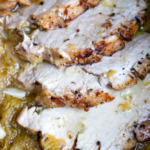
Our South German/Austrian boneless pork loin roast with sauerkraut recipe.
This is an authentic recipe for pork roast prepared without apples and brown sugar in a Dutch oven.
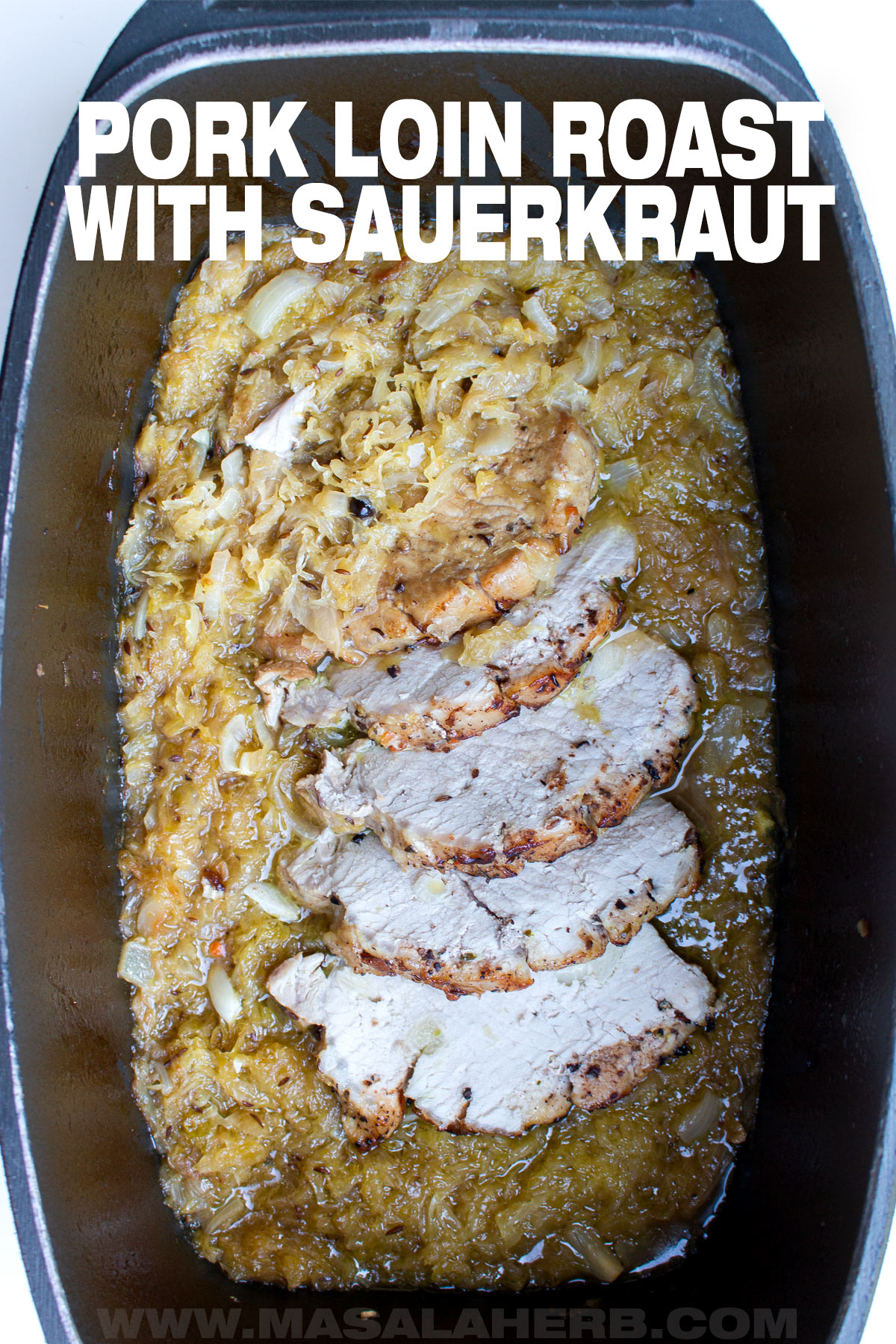
I share useful tips to get make the juiciest and most tender pork loin roast ever! The recipe comes with process images and a video.

Global Food Recipes
with Spices and Herbs
Free E-Book available for a limited time. Grab yours now and get instantly inspired!
You missed out!
Jump to:
What is this pork and sauerkraut recipe?
I'm from Tyrol in Austria, a region bordering Bavaria in Germany. Pork and Sauerkraut go hand in hand, where I come from.
In fact, we still make our own fermented sauerkraut in earthenware crock pots every year after the cabbage harvest.
This recipe is a variation of the regular boneless pork loin roast recipe cooked with potatoes.
In this recipe, instead of potatoes, we use sauerkraut as an ingredient and side dish, that is cooked with the meat together in a Dutch or a French oven (that's the name of the baking dish).
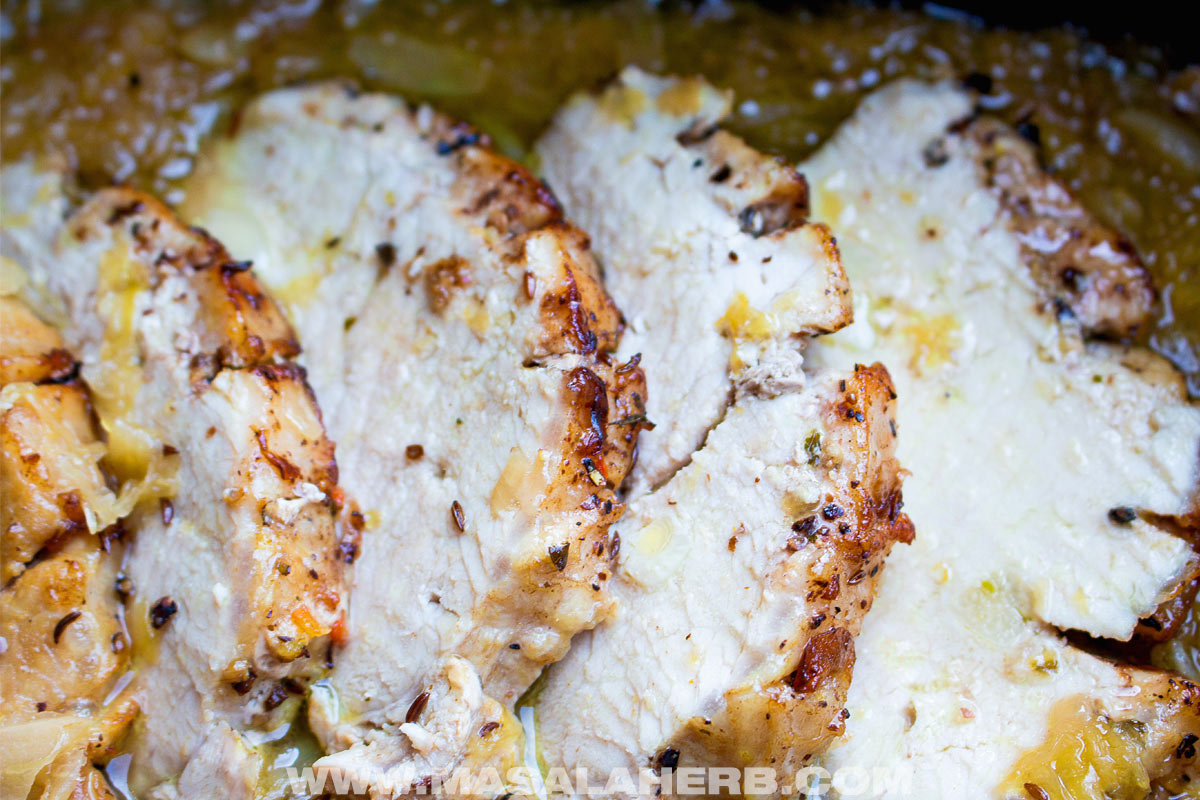
The meat is first seasoned and placed with onions in the large Dutch oven baking dish. Then it is seared over the stove top on all sides.
Sauerkraut is then seasoned and cooked over the stove top first before it is added to the pork roast. At last, meat, and cabbage get to roast in harmony together at high heat levels in the oven.
Some regions in Germany (mainly Hessen) eat Sauerkraut for good luck on New Year's Day, but not with pork. I saw some websites mention that incorrectly and thought to correct that.
Similar good fortune traditions exist on New Year's Day across German-speaking regions, with lentil soups and marzipan pigglets.
Ingredient Notes
The recipe is separated into two sections, the pork roast and the sauerkraut ingredients.
What you will need for the pork loin:
- Pork Loin – boneless with fat cap (important!)
- Garlic – fresh pods only!
- Black Pepper – Freshly ground is the best
- Clove spice – ground
- Salt
- Onion – red, white, yellow, any.
- Lard or Pork Fat – can be substituted with butter
- Bay Leaves
- Caraway Seeds – you can substitute with cumin or celery seeds, but the flavor won't be the same.
- Juniper Berry (optional if you can't get it)
- Broth or Water with Bouillon Cube (we like to use vegetable bouillon at home)
- Water and All-Purpose-Flour to make a Slurry
What you will need for the Sauerkraut:
- Lard or Pork Fat – can be substituted with butter
- Onion – red, white, yellow, any.
- Sauerkraut – store bought or homemade
- Caraway Seeds – you can substitute with cumin or celery seeds, but the flavor won't be the same.
- Bay Leaf
- Juniper Berries (optional if you can't get it)
- Black Peppercorn – whole
- Beer – Wheat beer, malt beer, craft beer or dark beer, whichever you prefer.
Process Overview
Step 1
Score the meat. Cut holes into the meat and stuff with fresh garlic pods.
Season all over.
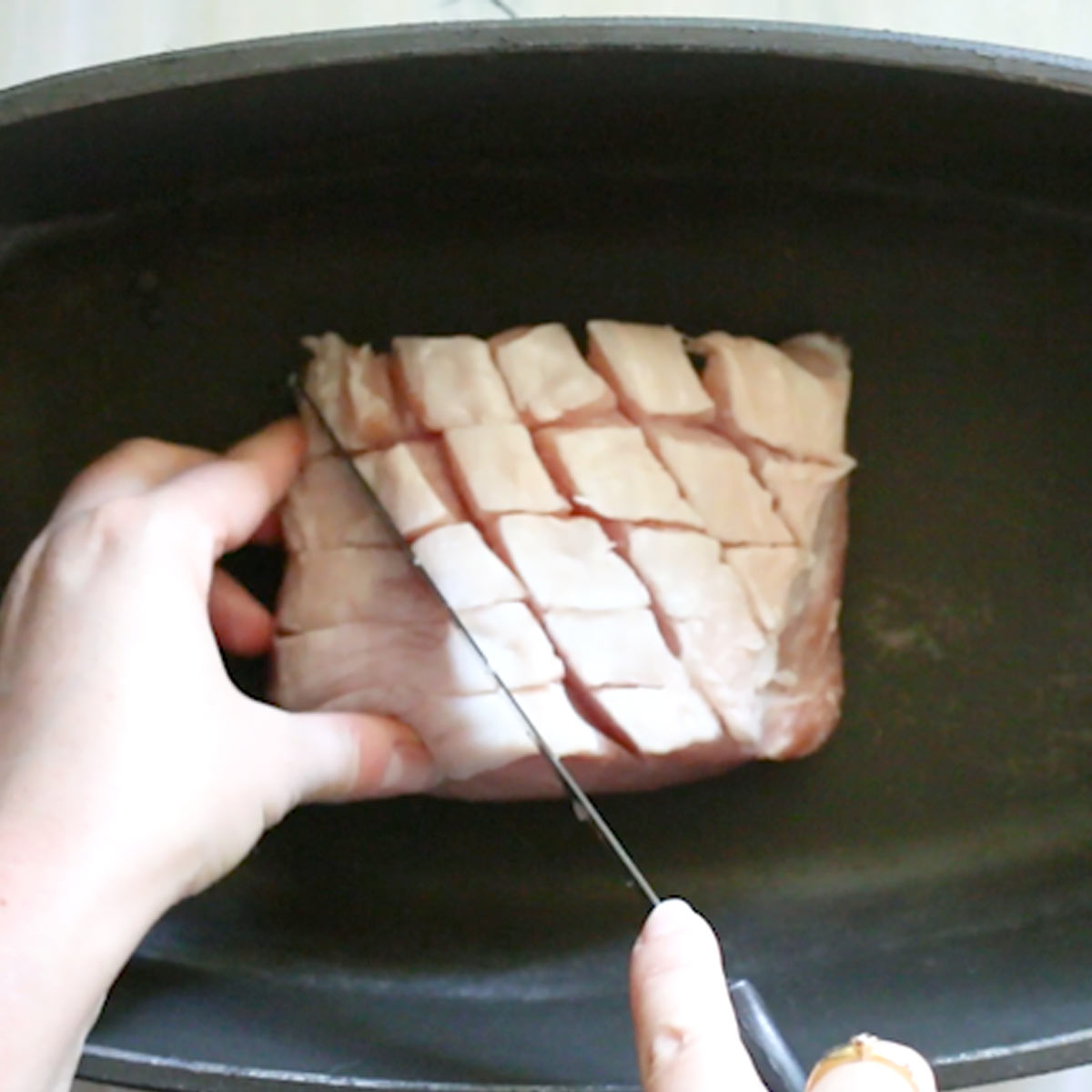
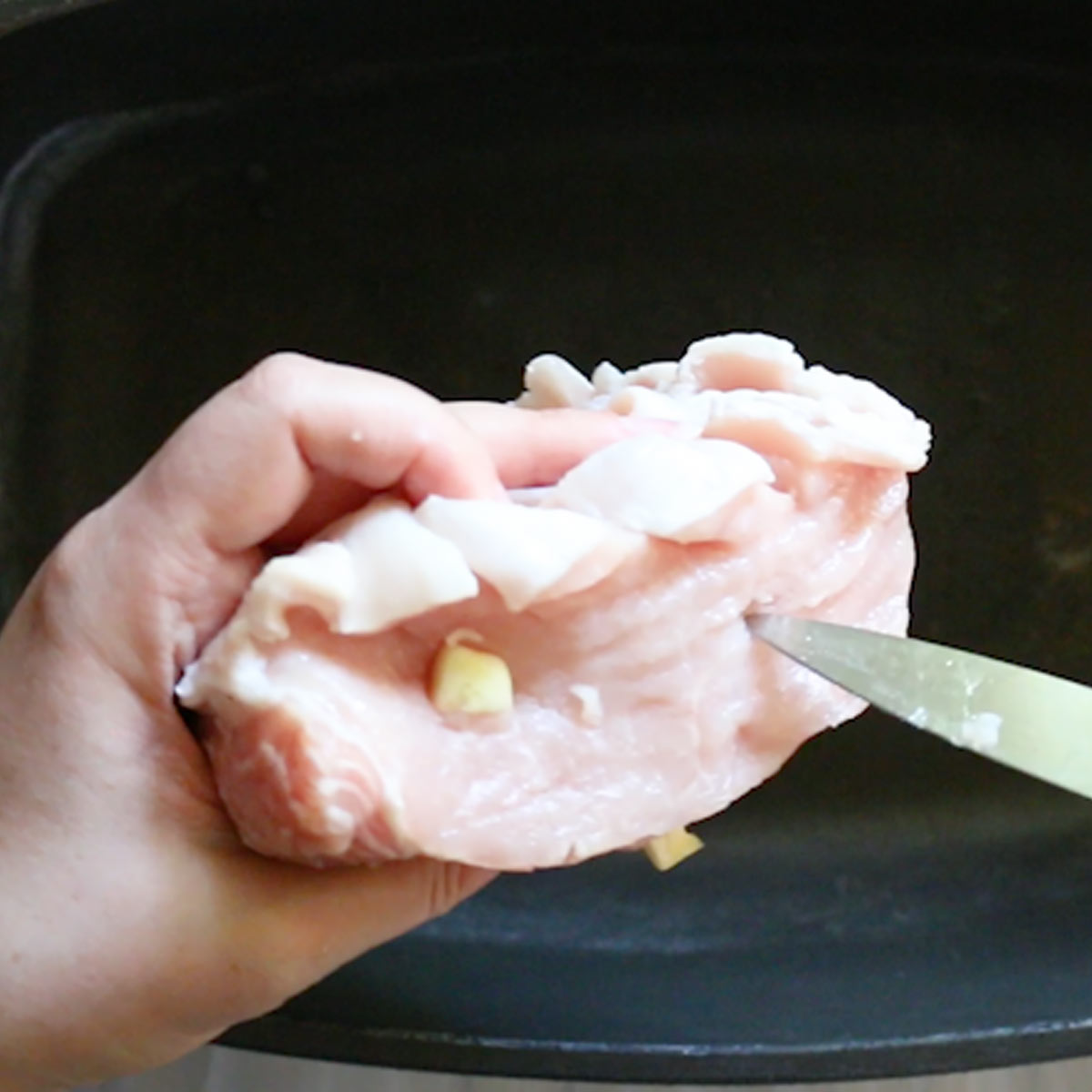
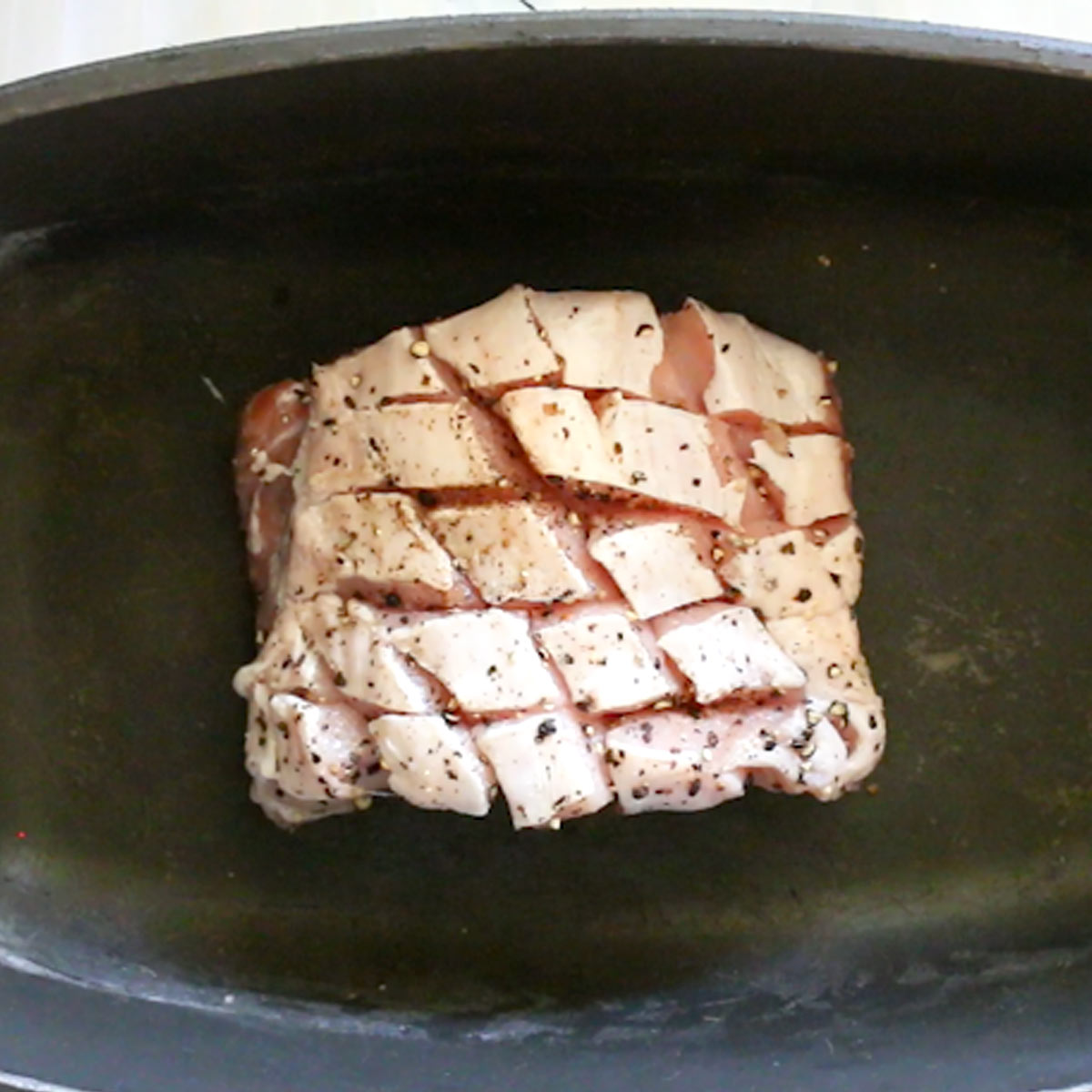
Step 2
Place the meat into a Dutch oven with sliced onion, lard, whole spices.
Sear over the stove top on all sides. Pour broth over the meat.
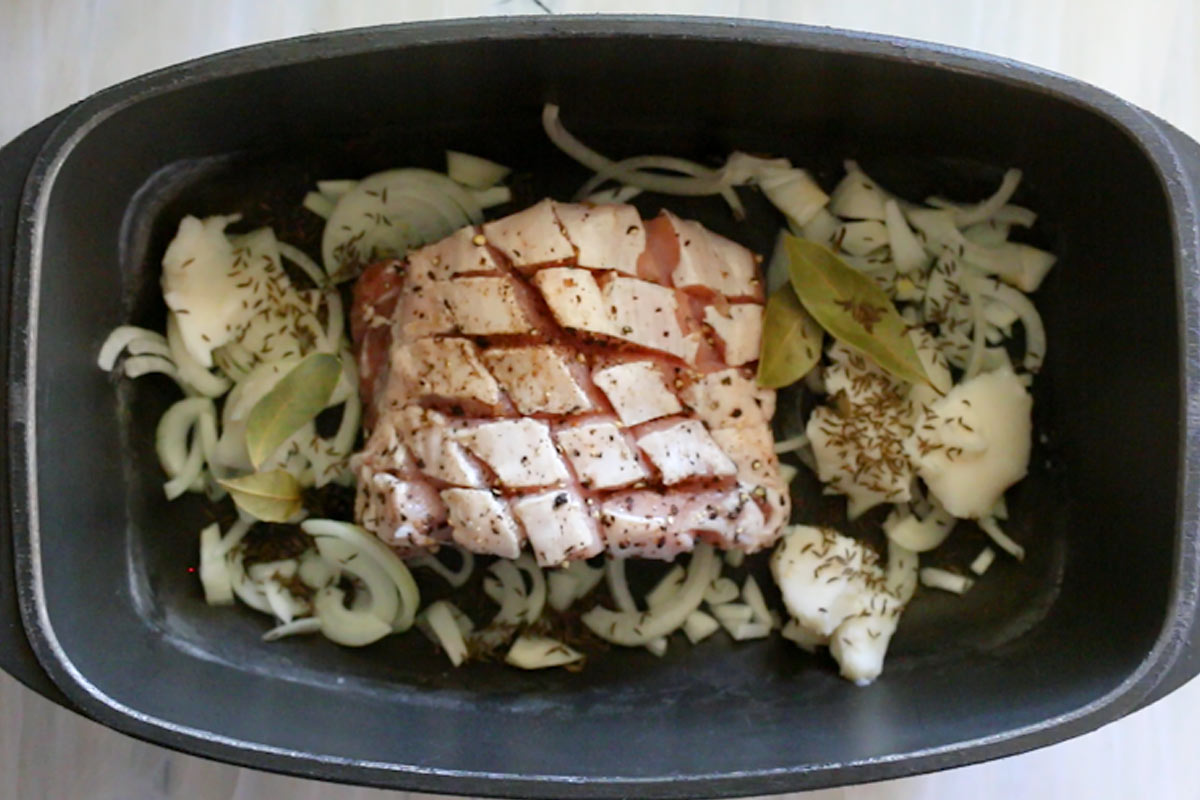
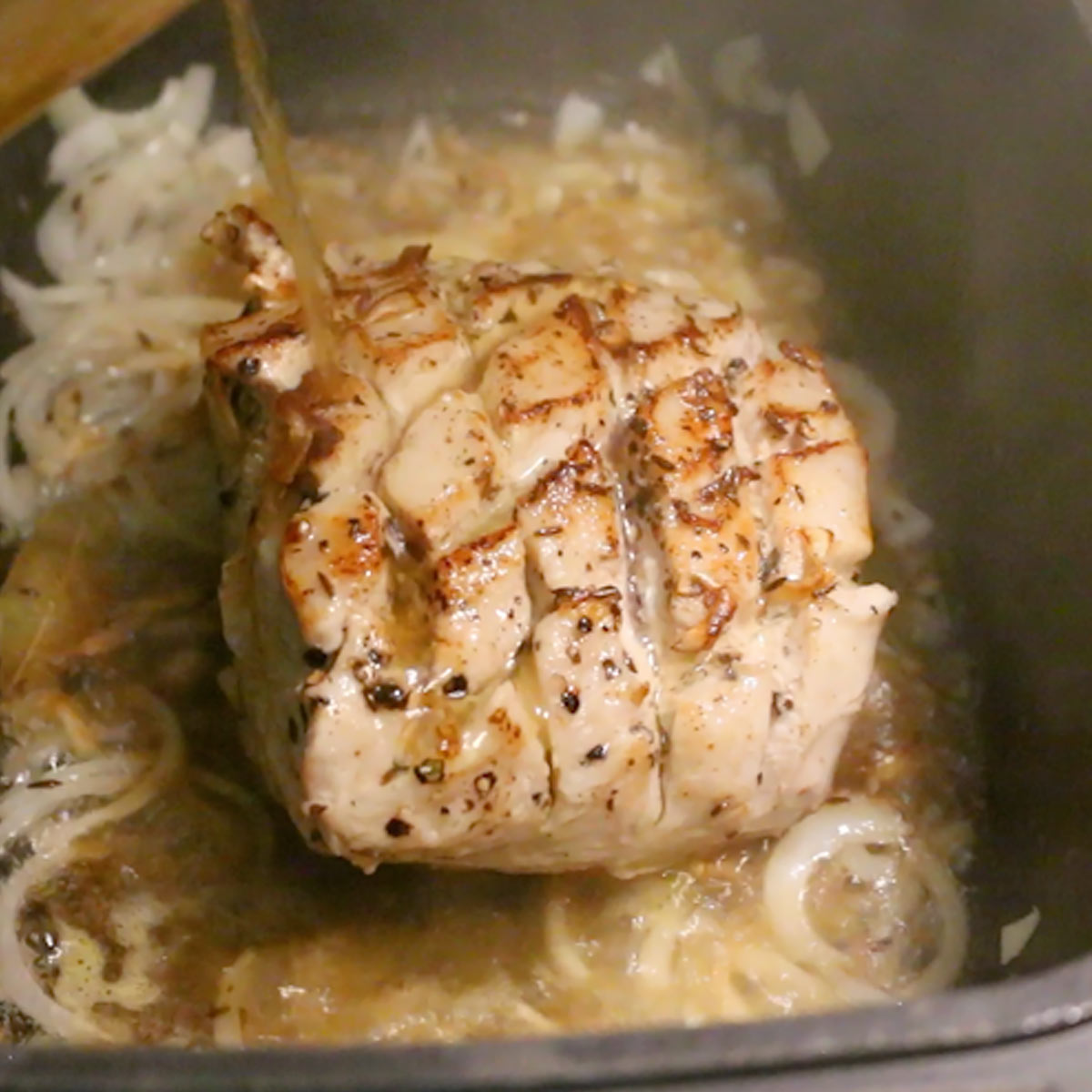
Step 3
Roast covered for about 10 minutes.
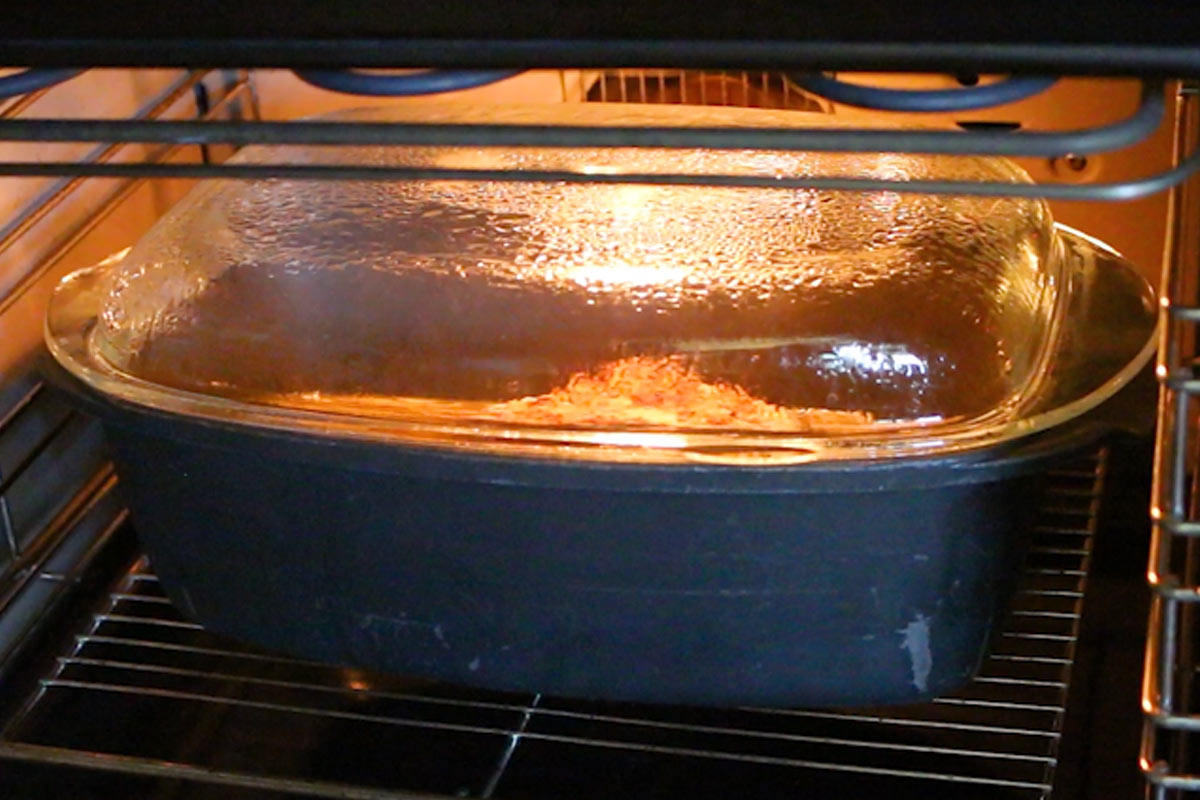
Step 4
In the meanwhile prepare the Sauerkraut.
Heat pan with lard to sauté onion. Stir in Sauerkraut with entire spices.
Pour and stir in the beer. Cook for 10 minutes.
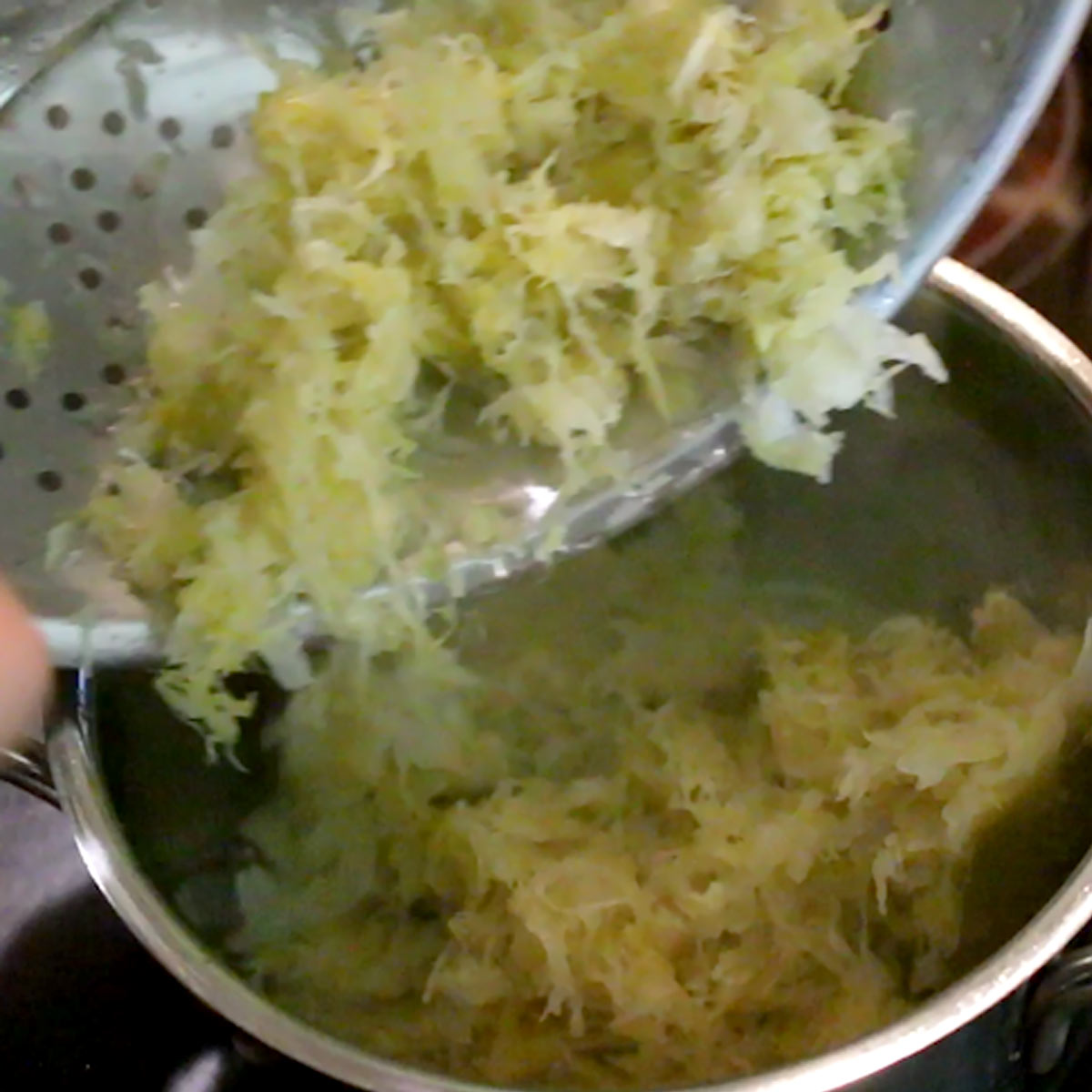
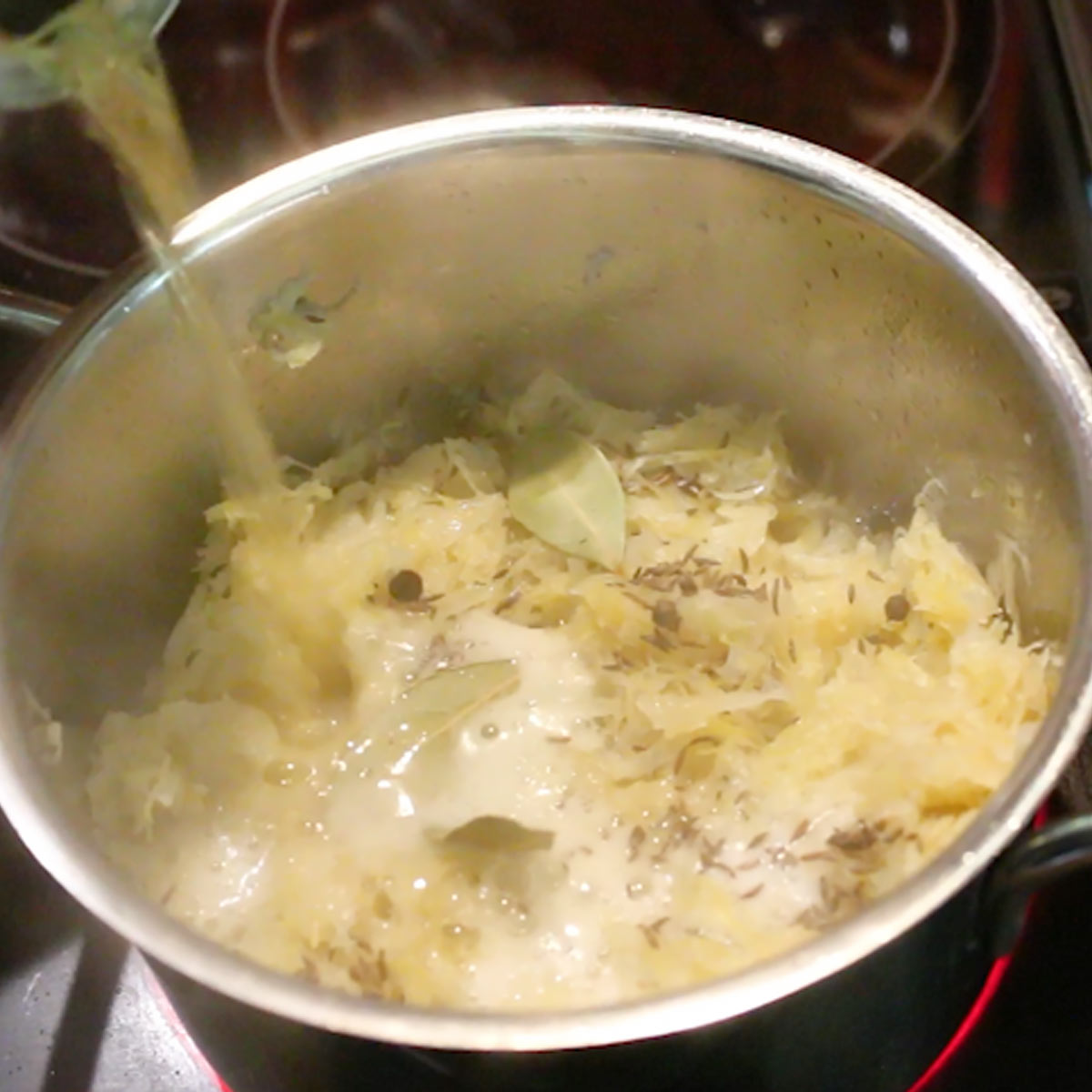
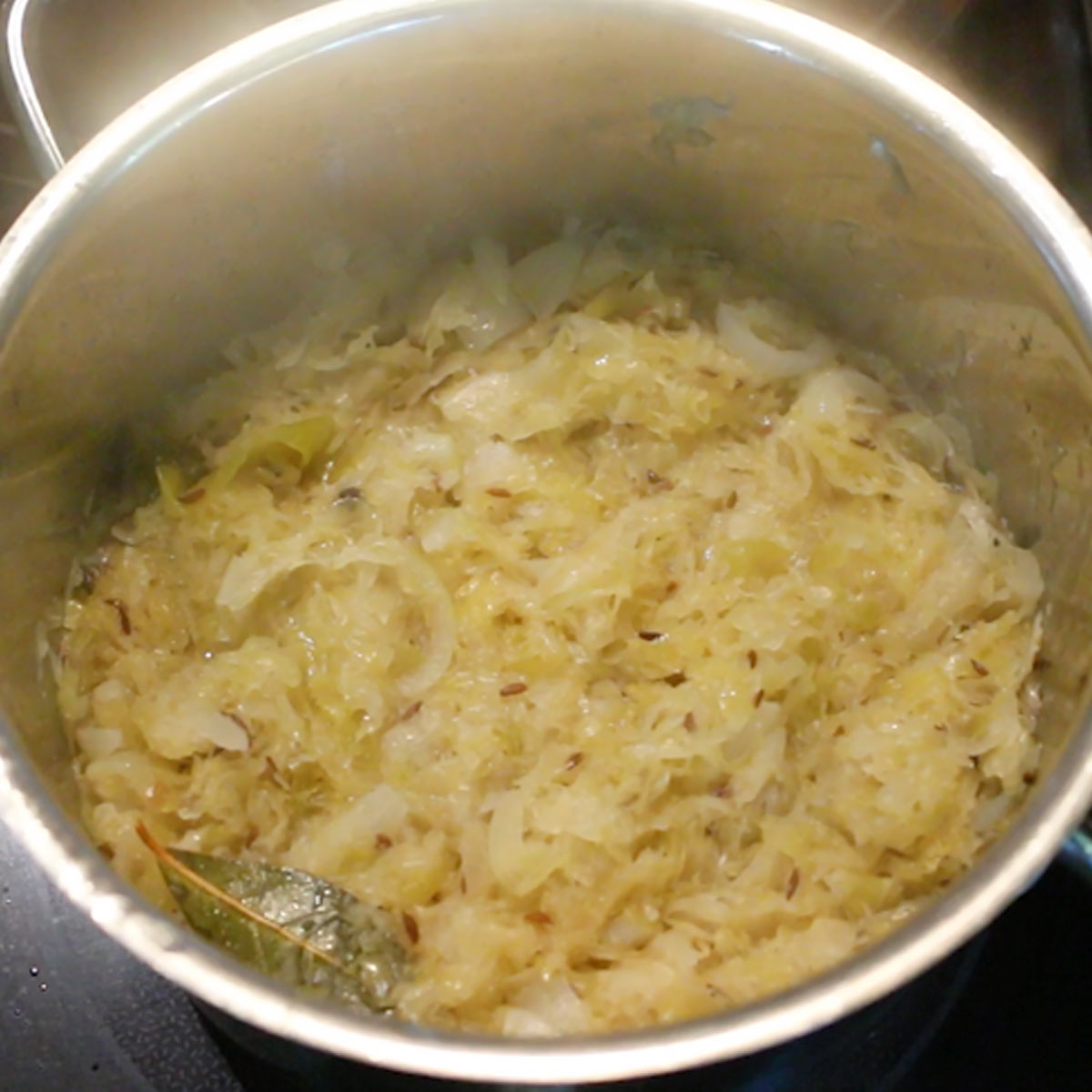
Step 5
Take pork roast out of the oven and pour water over it.
Cover again and roast for another 10 to 15 minutes.
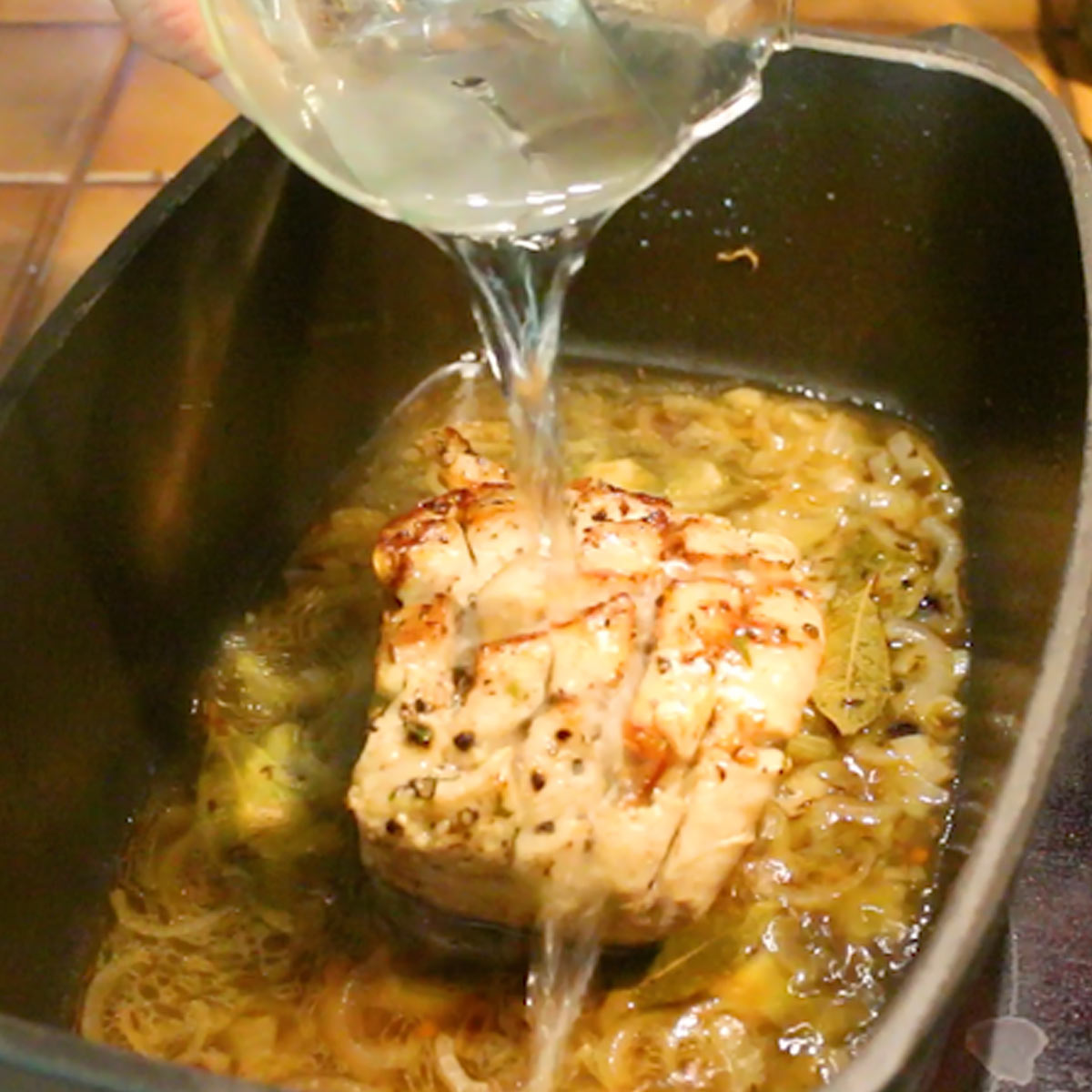

Step 6
Prepare a slurry by combining flour with water.
Take the Dutch oven from the oven and pour the slurry into the sauce.
Stir Sauerkraut into the Dutch oven.
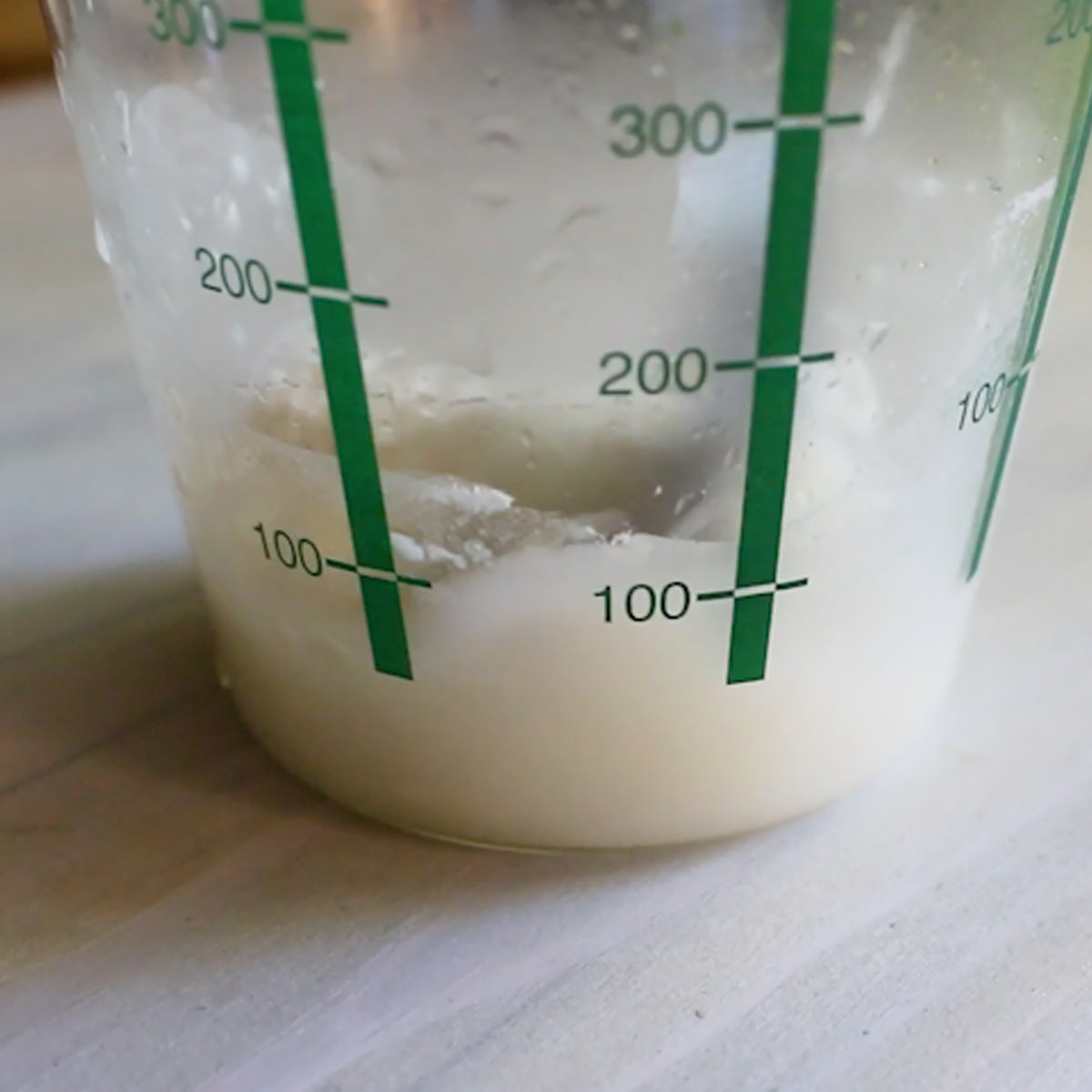
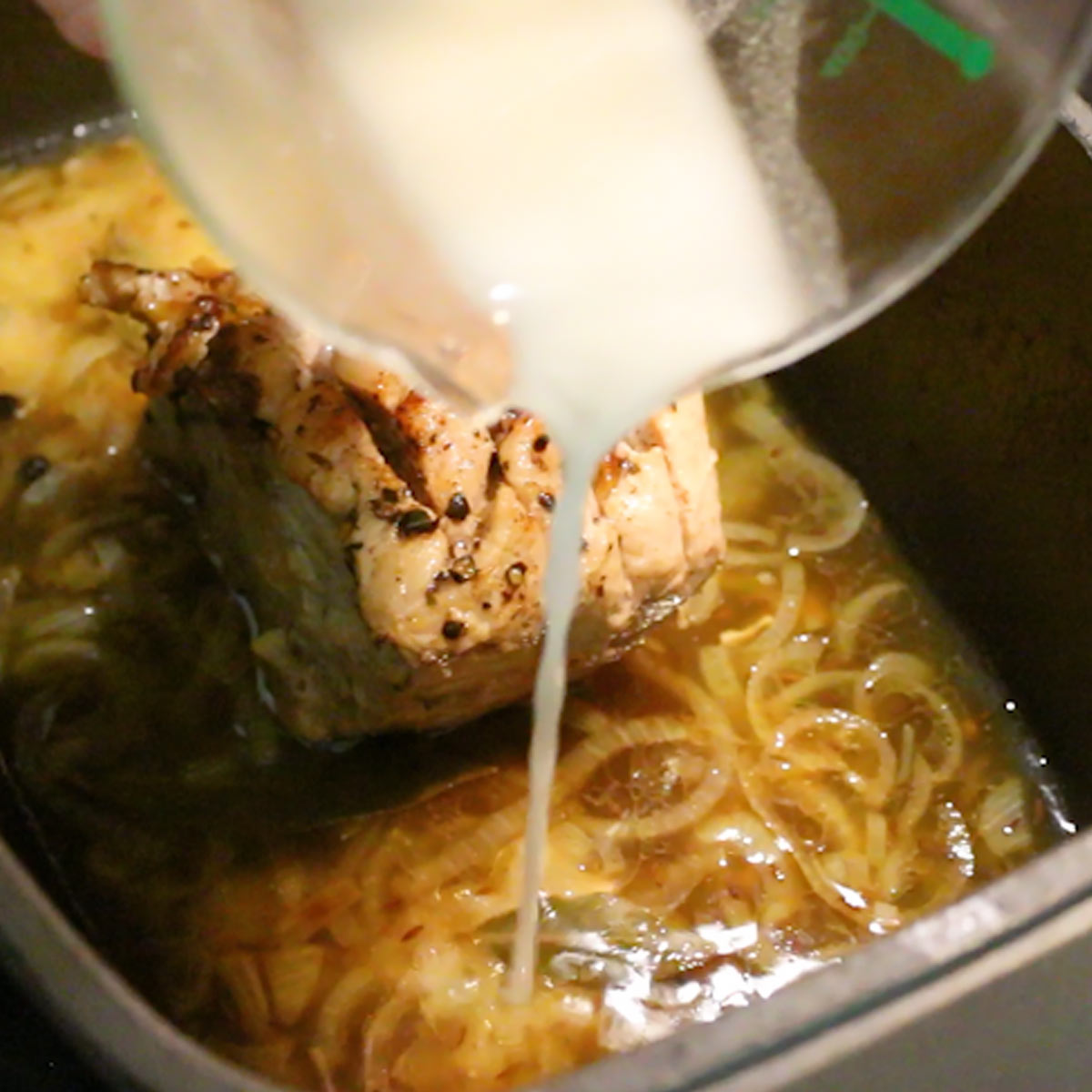
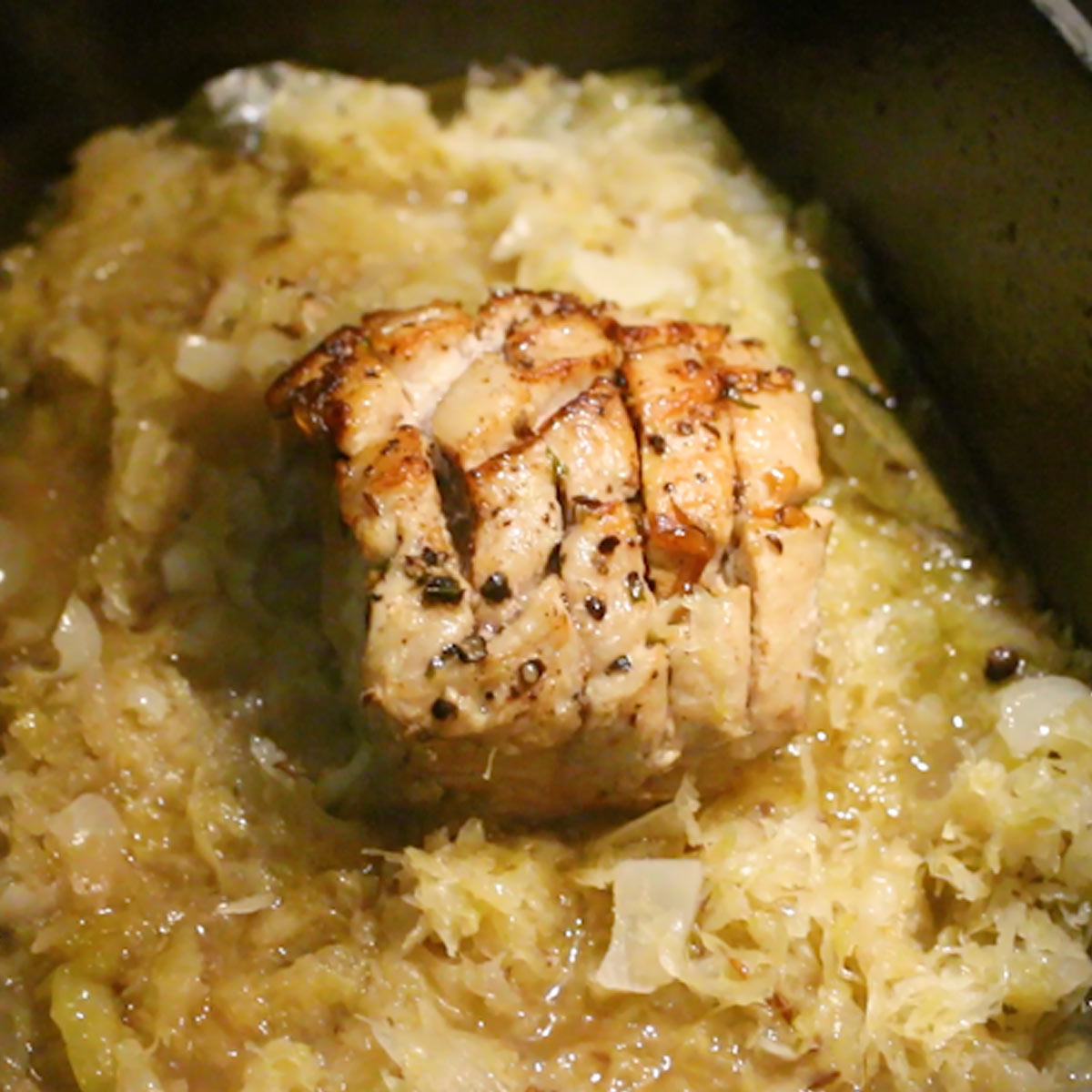
Step 7
Place the Dutch oven uncovered into the oven to roast for 5 minutes at 390 Fahrenheit (ca. 200 degree Celsius).
Check the interior heat of the meat. If it's below 145 Fahrenheit (ca. 63 °C), place back into the oven to roast for another 5 minutes, uncovered.
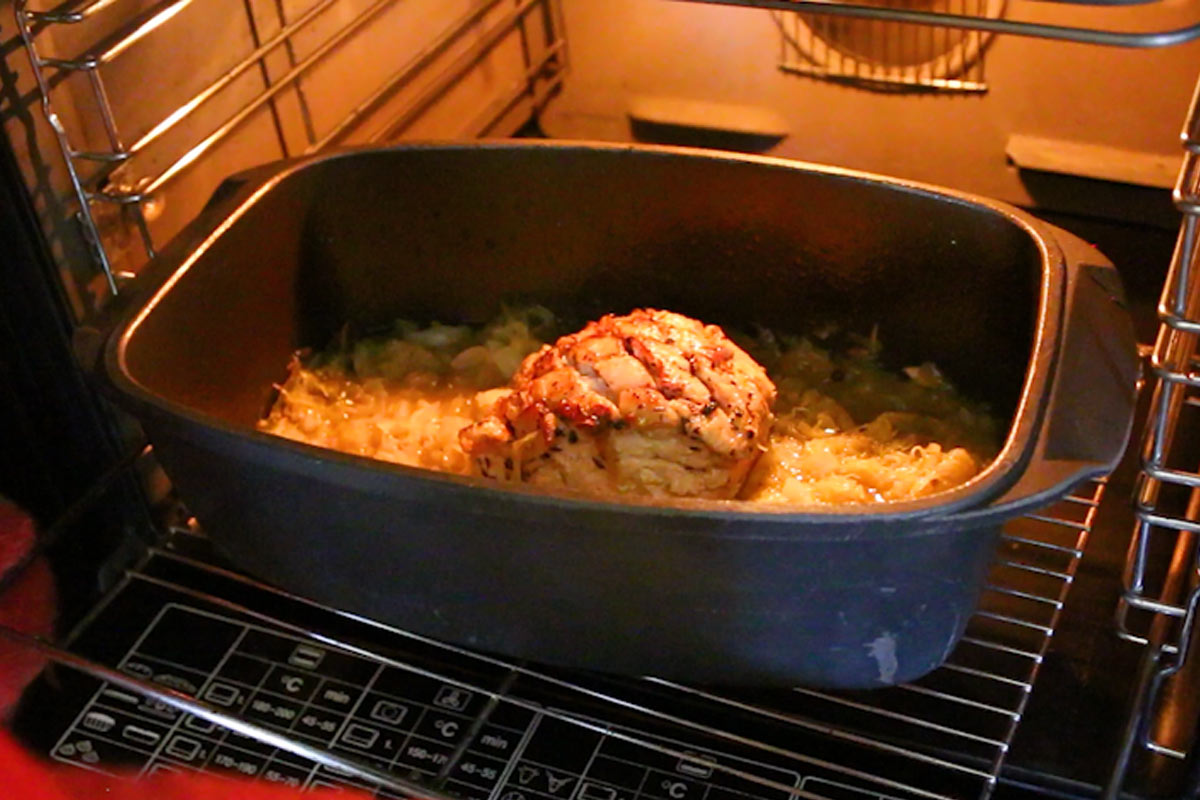
Step 8
When done roasting, keep out to cool.
Take out and discard whole spices, and cut into slices to serve up in the Sauerkraut.
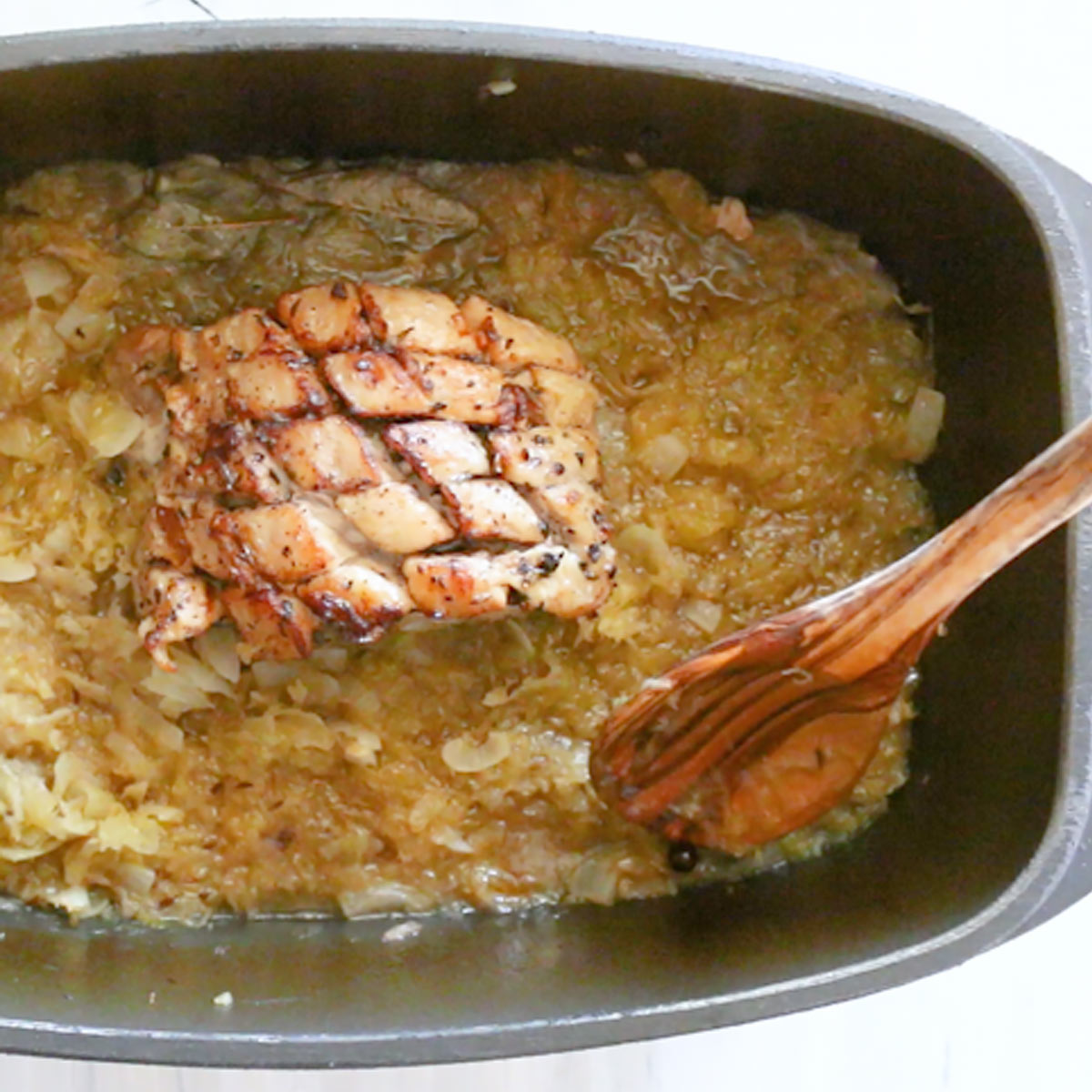
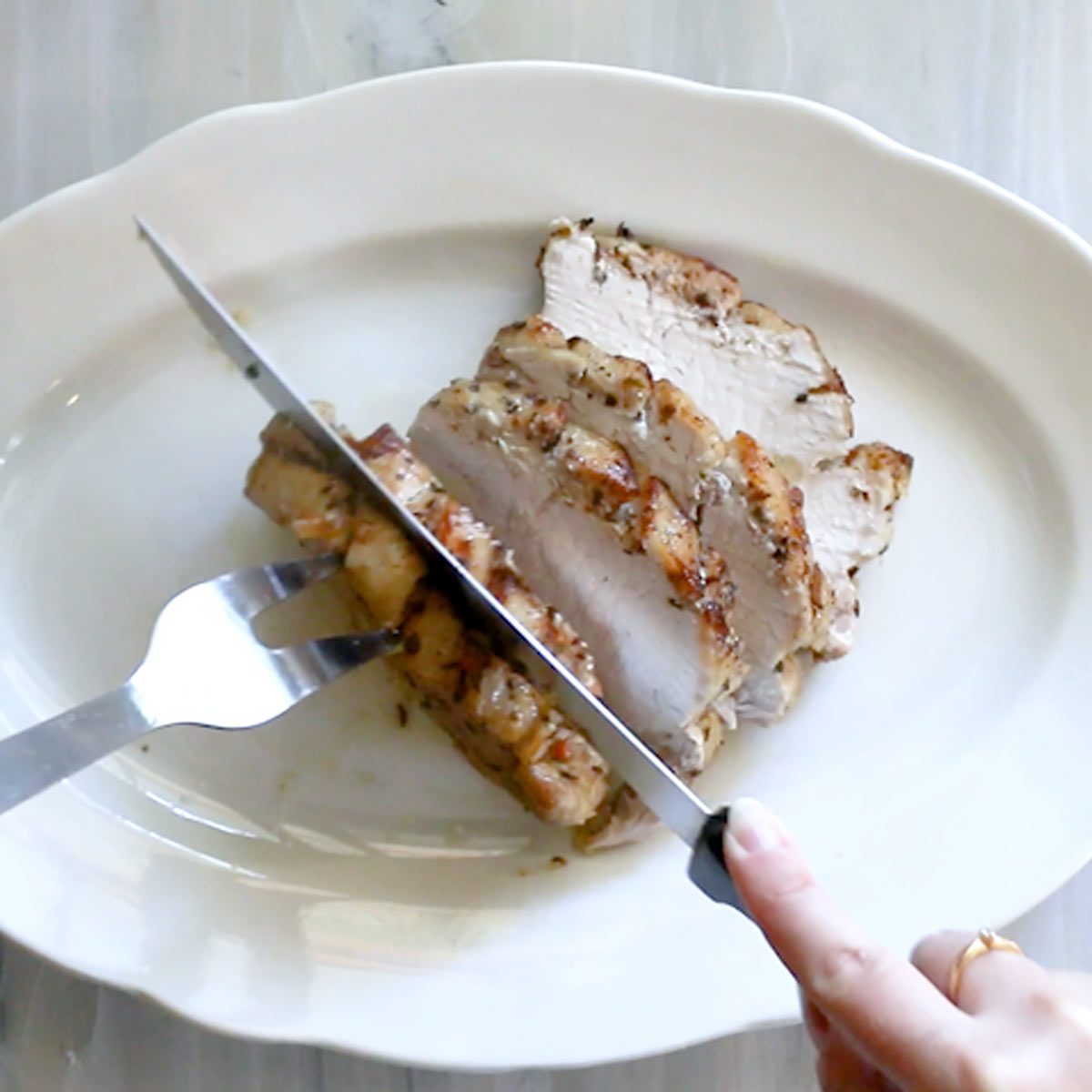
📖 Recipe

Pork Loin Roast with Sauerkraut Recipe
Ingredients
For the Pork Loin Roast:
- 1.2 Pounds Pork Loin boneless
- 4-5 Cloves Garlic Clove fresh
- ½ Teaspoon Black Pepper
- 1 Teaspoon Clove Ground
- ½ Teaspoon Salt
- 1 Large Onion red, or yellow or white sliced
- 2 Tablespoon Lard or pork grease or butter
- 2 Pieces Bay Leaves medium size
- 2 Teaspoon Caraway Seeds or cumin or celery seeds
- 5 Pieces Juniper Berries optional if you can't get it
- 1¾ Cup Broth or bouillon cube dissolved in water
- 1 Cup Water
For the Sauerkraut:
- 1 Tablespoon Lard
- 1 Medium Onion red or yellow or white sliced
- 1 Pound Sauerkraut *see notes
- 1 Teaspoon Caraway Seeds Whole if you don't have that, skip it
- 1 Large Bay Leaf
- 4 Pieces Juniper Berries if you don't have that, skip it
- 6 Pieces Black Peppercorns Whole
- Salt optional, to taste
- 1½ Cup Beer *see Notes
For the Slurry:
- ⅓ Cup Water lukewarm
- 1 Tablespoon All-purpose Flour
Instructions
Pork Roast
- Preheat oven to 460 Fahrenheit (ca. 240 degree Celsius).
- Score a grid into the fat cap. The meat will roast better that way and the fat will fuse to the meat and turn crispy.1.2 Pounds Pork Loin
- Cut a few holes all over into the meat and stuff each hole with a garlic clove half. A full garlic clove can be used if the garlic cloves are small.4-5 Cloves Garlic Clove
- Place the raw pork loin into the Dutch oven. Sprinkle some black pepper, ground clove and salt over the fat cap and massage it in. Repeat the process and season the rest of the meat all over with the remaining seasoning.½ Teaspoon Black Pepper, 1 Teaspoon Clove Ground, ½ Teaspoon Salt
- Spread sliced onion around the meat in the Dutch oven. Drop the lard into that too, with the caraway seeds, bay leaf and juniper berries.1 Large Onion, 2 Tablespoon Lard, 2 Pieces Bay Leaves, 2 Teaspoon Caraway Seeds, 5 Pieces Juniper Berries
- Take the Dutch oven to the stove top and sear the pork loin over a medium high heat setting. Cook the meat on all sides golden brown. The onion will get a bit soft too. This can take about 5 minutes.
- Place the pork loin with the fat cap up. Pour broth over the meat and into the Dutch oven to the onion.1¾ Cup Broth
- Cover the Dutch oven and place into the oven. Roast covered at 460 Fahrenheit (ca. 240 degree Celsius) for 10 minutes.
- Take out the Dutch oven and pour a cup of water over the roast. Cover again and take back to the oven, but this time at 400 Fahrenheit (ca. 200 degree Celsius) for about 10 – 15 minutes.1 Cup Water
Sauerkraut
- If you use homemade fermented Sauerkraut, rinse it first. This is necessary because it's super salty. You don't need to do this with store-bought package Sauerkraut!1 Pound Sauerkraut
- Place lard into a pan and heat it up to melt. Stir in sliced onions. Sauté onions soft.1 Tablespoon Lard, 1 Medium Onion
- Stir in the Sauerkraut with the seasoning. Add the caraway seeds, bay leaves, juniper berries, and whole peppercorns. Season with salt to taste. Mix it all in.1 Pound Sauerkraut, 1 Teaspoon Caraway Seeds Whole, 1 Large Bay Leaf, 4 Pieces Juniper Berries, 6 Pieces Black Peppercorns Whole, Salt
- Pour and mix beer into the Sauerkraut.1½ Cup Beer
- Cook Sauerkraut for about 10 – 15 minutes over a medium low-heat setting, so that the Sauerkraut gains on flavor.
Combine Pork Roast and Sauerkraut
- Prepare a slurry by mixing the flour into water.⅓ Cup Water, 1 Tablespoon All-purpose Flour
- Take the roast out and pour the slurry into the sauce of the pork roast.
- Stir and mix Sauerkraut into the Dutch oven sauce so that the meat is surrounded by Sauerkraut.
- Place the Dutch oven uncovered into the oven to roast for 5 minutes at 400 Fahrenheit (ca. 200 degree Celsius).
- At this point, check the interior temperature of your pork loin roast. The roast is done between 145 and 160 Fahrenheit (63 and 71 degrees Celsius) with the latter being medium and the first medium rare. If the temperature has been reached, your roast is done. If it's not done yet, take it back into the oven for another 5 minutes uncovered. Take it out when the pork roast is done (keep on checking with the thermometer).
- Once your pork roast is cooked, leave to rest for 3 minutes. Take out the whole spices and discard them.
- Take the meat out and cut into serving slices. Place the meat back into the Sauerkraut to serve up hot.
Notes
- Use a Meat thermometer to get the temperature and roasting part right!
- Your pork loin should come with a fat cap. This is important because the fat cap helps in keeping the meat tender and juicy.
- The caraway in the recipe can be substituted with cumin or celery seeds. You can't substitute juniper berries, so if you don't have them, skip adding.
- Lard can be substituted with pork grease (as in bacon drippings) or with butter.
- If you can't get caraway seeds, substituted with cumin or celery seeds. If you can't get juniper berries, skip adding them. Although, they do add a lot of flavor to the Sauerkraut.
- Use homemade Sauerkraut fermented in an earthen-ware crock pot OR unseasoned store-bought Sauerkraut. When we don't have enough homemade Sauerkraut, we also use commercially available Sauerkraut. It's allowed. 🙂
- You can use your favorite beer in this recipe. That can be craft, wheat, malt, barley, dark beer. If you want to substitute beer, you can do that with wine, but that's the version from Alsace in France. To make it alcohol-free, use water, but your Sauerkraut will lack some flavors.
Equipment
- 1 Dutch Oven for the roast
- 1 Medium Pot with Lid (5 qt) for the Sauerkraut
- 1 Meat Thermometer
Nutrition
Tips
- Get pork loin meat with a fat cap on it. This is important because the fat cap will make your roast juicy and tender. Pork loin without a fat cap will be a doomed cut of pork as it will turn out overcooked, dry and tough.
- Take out the meat from the fridge at least 30 minutes before you intend to season and sear it. That way the meat tissue gets used to the room temperature and won't need to be seared that long on the stove-top.
- Cut a grid design into the fat cut. This is so that the fats crispen and the heat cooks the whole roast more evenly.
- Salt on the fat cap makes it crispy when cooked under high heat in the oven. It somewhat fuses the fats to the pork meat.
- Use a thermometer to determine the internal temperature. A boneless pork loin is done cooking between 145 Fahrenheit (ca. 63 degree Celsius) and 160 Fahrenheit (ca. 71 degree Celsius).
Storing and Reheating
Leftovers of the sliced pork cuts and Sauerkraut can be stored in rectangular glass containers with lids in your fridge for up to 5 days.
I keep the Sauerkraut with the meat together so that the meat doesn't dry out.
In fact, you can portion them into batches, each a meal in itself for weekdays at work. This recipe is a great meal prepping meal!
Store your meat cuts and Sauerkraut in the fridge.
Reheat over a low-heat setting in your oven for a few minutes. Be careful to not overcook it, you just want to make the dish hot. Or else the meat will turn out chewy.
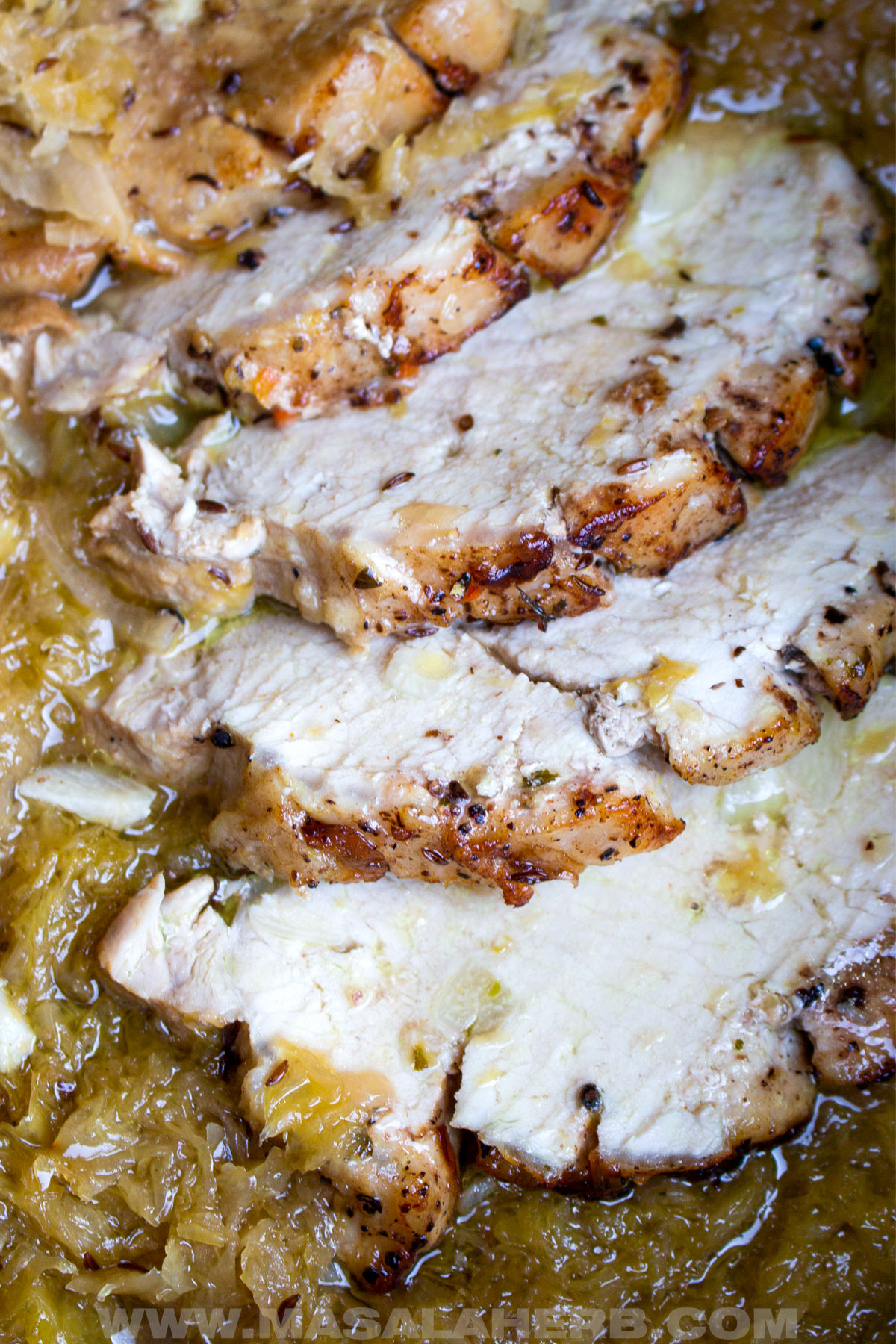
Serving Ideas
Because this pork loin gets smothered between juicy cabbage sauerkraut at the end of the cooking cycle, you don't really need another side dish with this complete meal. It's a one pot meal!
Yet, you are free to pair other side dishes with this pork and sauerkraut. Here are some ideas:
- Skillet potatoes with fresh parsley
- Mashed Potatoes
- Bean salad as in scarlet runner bean salad with green pumpkin seed oil
- Creamy cucumber dill salad
- Shredded radish salad with vinegar dressing.
- Dumplings as in potato dumplings (Kartoffelknödel/ Erdäpfelknödel) or bread dumplings (Semmelknödel)
We love adding condiments to this dish and pork and sauerkraut really go well with sharp pungent sauces and add-ons. These are our favorites in Austria and Bavaria:
- Ground homemade horseradish – Pungent side that goes well with pork.
- Jam with lingonberries – Sweet with tart aromatic flavors, served as a sauce. We collect lingonberries in the mountains in the wild.
- Mustard sauces – Many variations exist across Europe. Locally in Austria and Bavaria you can get sweet brown-colored mustard and some contain horseradish. You can also use Dijon mustard or wholegrain mustard paste.
We usually enjoy wine or beer with our pork roast. For beer, I recommend wheat beer, such as a Bavarian Weissbier.
If you prefer having wine, I recommend a neutral white wine such as a pinot gris or a riesling. A rose is also a good choice, such as a rose d'Anjou.
FAQs
No, a pork loin and tenderloin are two different meat cuts, and you can't use them interchangeably. Tenderloin, as the name indicates, is the most tender meat cut and also the most expensive one. It's located at the read of the pork loin. The pork loin, on the other hand, is located on the back of a pig between the shoulder and the rear.
Depending on the size of your pork loin, it can take anywhere between 8 and 10 hours to thaw through completely. In this case, it's easier to work with two smaller pork loin meat pieces. I recommend placing your pork loin in the fridge overnight to thaw slowly overnight.
Pork shoulder is also called pork butt (I know confusing, right?) but the two meat pieces are not the same and are, in fact, located side by side. Both are located above the pork loin and the meat is very similar to pork loin cuts. You can substitute pork loin roasts for pork shoulder, but shoulder meat cuts need to cook longer, so add extra roasting time to the base recipe. I have personally not tried it yet, but you will most probably have to cook it for another 10 minutes at least. I recommend using a meat thermometer to get the inner meat cooking temperature right.
The minimum inner meat temperature that you need to set on your meat thermometer is 145 Fahrenheit (ca. 63 degree Celsius) for medium rare. For medium cooked set it at 160 Fahrenheit (ca. 71 degree Celsius).
The pork loin is first seared on all sides with the onions over the stove top. This is to bring out the flavors of the meat and to get some color on all sides of the pork cut. I don't recommend skipping this step!
Yes and no. The pork roast is covered during the main roasting process, but it is uncovered at the end during the last 10 or so minutes.
A tough cooked pork loin roast is an indication that your meat cooked for too long. Take away the guess work and use a meat thermometer. The inner temperature of your roast should not exceed 160 Fahrenheit (ca. 71 degree Celsius). I recommend taking out the roast at 155 Fahrenheit (ca. 68 degree Celsius) and allowing the pork to rest for a few minutes at the outside temperature because leftover heat will still cook it a little more. This is known as carry-over cooking. Another point to consider is the quality of meat cut. Poor quality meats will turn out tougher. I recommend getting meat from a quality and trustworthy source. Besides all that, pork loin meat is known to be lean meat cut, and they usually come with a fat cap on it. Don't cut off the fat cap! The fat cap essentially helps in keeping your meat juicy and tender.
More Recipes like this
- Seasoning for pork roast – but I don't advise using this seasoning in the pork roast with sauerkraut recipe.
- Pork tenderloin stuffed with garlic
- Pork tenderloin fillet with mushrooms
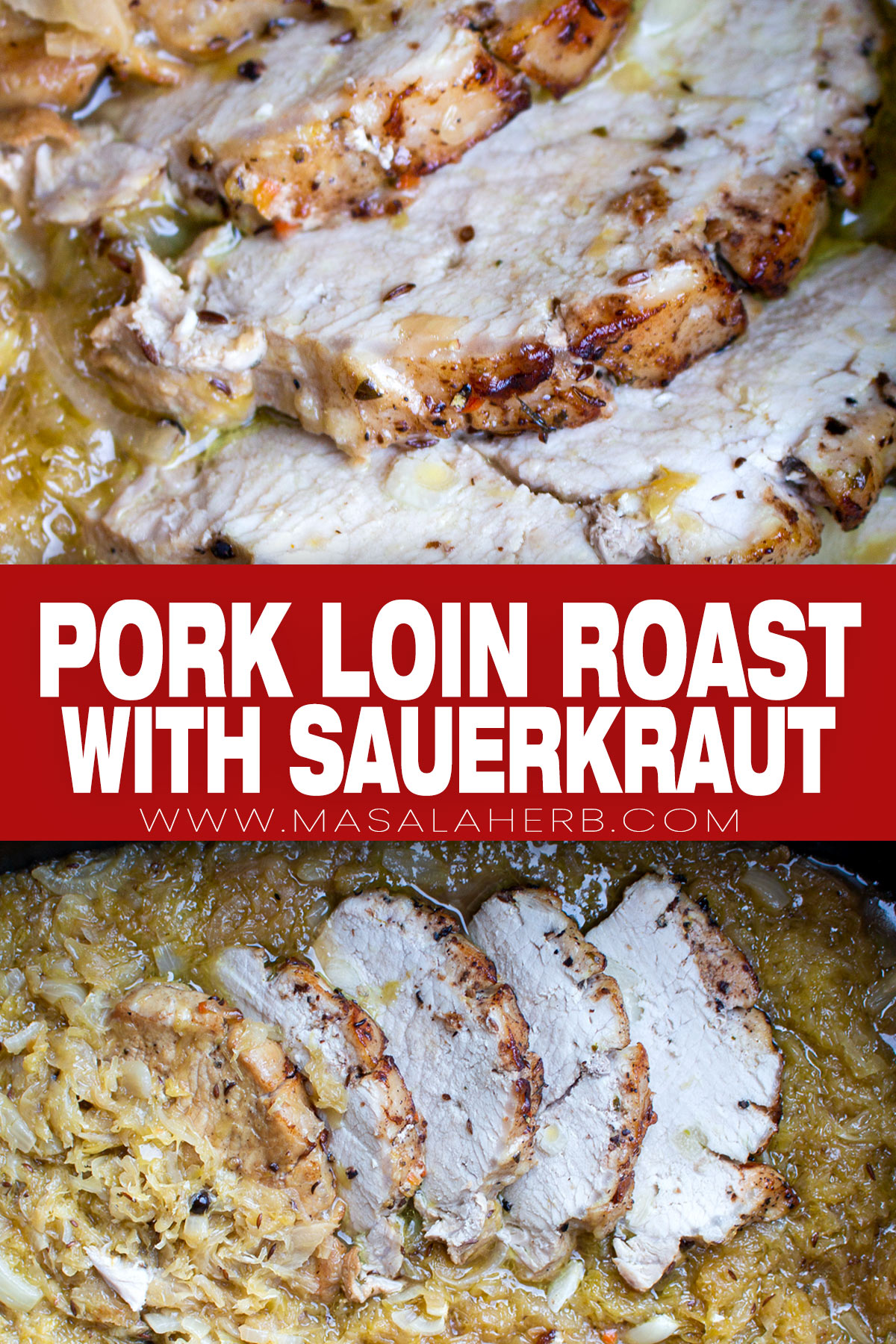


Comments
No Comments